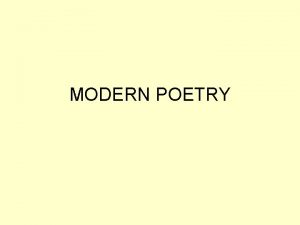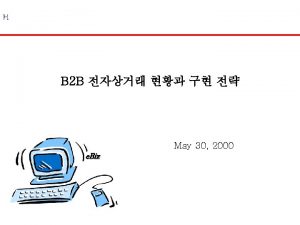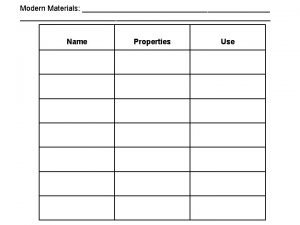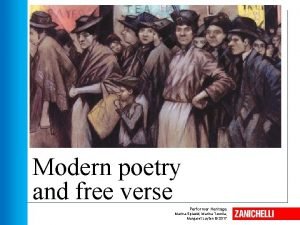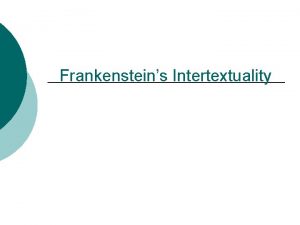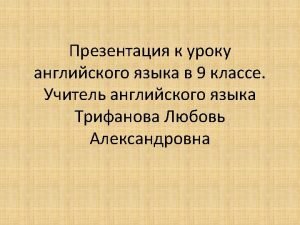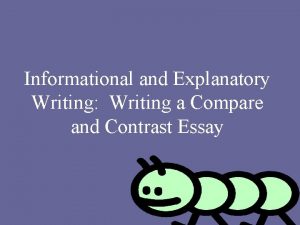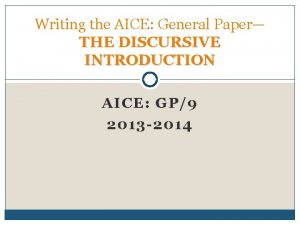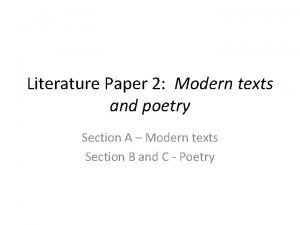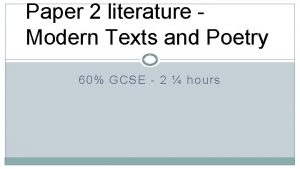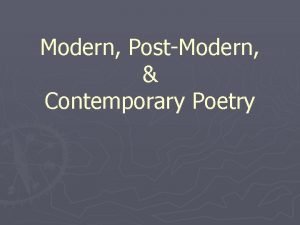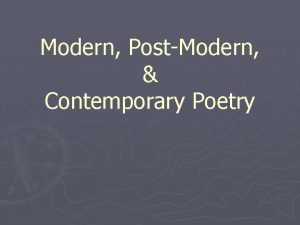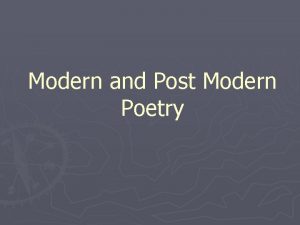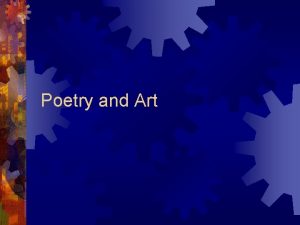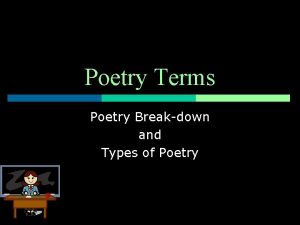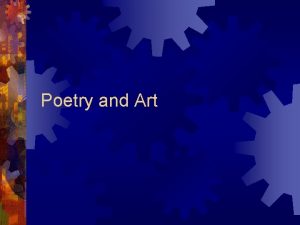Paper 2 Modern texts and poetry GENERAL OVERVIEW













- Slides: 13

Paper 2 Modern texts and poetry GENERAL OVERVIEW Students who knew the text were able to move around and within it in order to respond to the specifics of the task. One member of the team commented that his future teaching strategy will be to ‘free up all my lessons and really focus on the ‘big ideas’ in texts after the experience of examining this year’. Students made huge efforts to use subject terminology and many did so with accuracy. However, at times students were more concerned with the use of technical terms than the effect. Students should remember that critical terms should be used judiciously and must always be linked to effect on the reader/audience. The use of structures such as PEE / PEA and its variants worked in the sense that they allowed students working at the lower levels to access Level 3 in the mark scheme. However less rigid structures worked better for those working at higher levels. overview • students choose shorter, more pithy quotations; students don’t use as many [sometimes unnecessary] quotations • Students who answered the question generally did better than those who were confined by formulaic, AO-driven responses • Students who answered the question did better on AO 3 than those who tried to include biographical and / or historical information, which is difficult to credit.

Paper 2 Modern texts and poetry Section A: The Modern Text Those who knew their text were able to refer to different points in it and demonstrate their understanding that way. There were a number of very impressive responses where the student had taken a more holistic view of the text as a whole. Students who dealt with AO 2 most successfully were the ones who had not been too restricted by subject terminology Students who rooted their response in their selected task put themselves in a stronger position. The key words in each question point students toward the three AOs being assessed, so those who took this approach naturally gave themselves a firmer foundation from which to develop an appropriate response. Some students became tied up in the confusion and found themselves wrongly identifying parts of speech without actually saying anything about meaning, let alone effects. There A There were however some very successful treatments of AO 2 that concentrated on why and how a writer has crafted a character / moment / exchange of dialogue / point of tension A short, alongside the acknowledgment that this is [dramatic irony], followed by a consideration of why the author chooses to present [character] in this way, is a good example of how AO 2 can be addressed. Sometimes, too much terminology impeded responses and seemed to constrict liberation of ideas and expression.

Paper 2 Modern texts and poetry Section A: The Modern Text The examining team noted that the flexible approach to context meant that whilst there were examples of bolt-on context, such responses often went on (eventually) to tie the context to ideas in the text so that it was possible to ignore the isolated history excerpts and award the marks elsewhere. Some students moved into Level 6 for AO 2 via a thread that ran throughout their response explaining how the writer was working to present ideas rather than focusing solely on analysis of techniques, words or phrases Students who had used character development / purpose as their focus for AO 2 produced some very effective responses as they were explicitly focusing on writer as maker of the text A The best students integrated contextual ideas seamlessly in other words, they answered the question. Those who created a flow between context and text/task that enabled them to explore the task effectively

Paper 2 Modern texts and poetry Section A: Taught Poetry Rather than being a discrete AO, comparison is now viewed more holistically as one of the ways that students approach the task. The lack of a requirement to adhere to a rigid comparative structure enabled students to illustrate how two poems deal with the same theme in a variety of organisational ways Examiners are looking to reward the level at which the student has connected the two poems in the light of the focus of the question. The selection of the second poem is one of the keys to success as this gives the student the material to construct a holistic response. Some students had clearly been taught to approach Section B via a comparative mechanism and this worked well for those who were able to manage it. However, even those who were more discrete in their comparative approach were able to demonstrate a comparative understanding B Section B responses were most successful when students established a point of comparison through an idea/attitude. This usually led to them being able to make effective, detailed comparisons within the response. The key message here is to enable and guide students to form a comparison relative to their level of ability. Those who find it difficult to construct intrinsic, integrated comparisons might find a reflective comparative structure to be more useful.

Paper 2 Modern texts and poetry Section A: Taught Poetry One examiner commented that one of their key teaching points for next year will be that ‘comparison comes in a variety of shapes and does not have to be formulaic’. Students who recognised where the voice was a construct were more successful than those who regurgitated biographical information about the poet that they then attempted to link to the poetic voice. In the more successful cases, students considered the effect on meanings / ideas of particular word choices, or structural elements such as beginnings and endings, or the implications of titles (seen particularly effectively with ‘Remains’ and ‘Follower’). The best responses pursued a line of argument in response to the question and the analysis of presentation grew out of the response as an illustration of the ideas expressed by the poets. Again, if students focus on the task they will naturally address AO 3 B Some responses set out to identify poetic techniques and employ as much terminology as possible before engaging with the poems themselves. These responses hampered the progression of any point of view / line of argument. Many examiners commented that there was a prevalence of biographical details about the poets, some of this material dominating responses. It is very hard to credit this information as the task is about the text not the poet, and therefore students were disadvantaged by the inclusion of this material

Paper 2 Modern texts and poetry Section A: Unseen Poetry A number of students focused on the writer’s ideas that lay behind the poem and these responses generated the highest marks. One factor that might be useful for future reference is that some students actually spent more time on Q 27. 2 than Q 27. 1, which was a shame as the balance of marks across the two tasks meant that they selfpenalised on 27. 1. The better responses to Q 27. 2 highlighted why and how the student had deciphered that one poem presented the season negatively and one positively. Fluency and articulation of ideas is vital in moving through the levels in Q 27. 2 and those students who could express their ideas more lucidly about each poem in a succinct way, often achieved Level 4. C Focusing on a handful of well-selected details to illustrate the student’s view led to a more productive use of time but this requires the student to have allowed themselves the space to read the poem and have an overview of the ideas. Often in Q 27. 2 there were more thoughtful ideas about ‘Autumn’ presented than in Q 27. 1, which might suggest that students need to pause and reflect before beginning their response to Q 27. 1. Some students struggled a little to focus on AO 2 for Q 27. 2, and therefore were unable to access many marks as the sole focus of this task is comparison of methods.

Paper 2 Modern texts and poetry KEY SKILL – Assessment Objectives OVERVIEW The most significant teaching and learning point that can come from this assessment methodology is to encourage students to respond to what the task has asked of them. The questions aim to elicit a response to all of the assessed skills (AO 1, AO 2 and AO 3), therefore if students focus on answering the question, they are putting themselves into the strongest position to do well. AOs The mark scheme is set up to reward students who answer the question rather than produce a formulaic response to assessment objectives in isolation.

Paper 2 Modern texts and poetry AO 1 Response to task and text The word ‘response’ refers to the student’s response to the task, and to the ideas in the text. It refers to ideas and meanings – both those in the text, and the student’s ideas about the text. There is a misconception amongst some students that the word ‘response’ is asking them to comment on an emotional and even personal level Those who consider the intention behind the eliciting of an emotional response are generally more successful AO 1 The best responses were less formulaic in the manner in which the student structured their paragraphs and made consistent clear links back to the task Phrases such as ‘this makes the reader feel’ can have a limiting effect on more able students. A more effective approach in terms of avoiding generalised comments might be to link to writer’s intention or to take a more reflective perspective Some students used the focus of the question to structure their response: using topic sentences directly linked back to the focus of the question

Paper 2 Modern texts and poetry AO 1 References Those who had planned and focused carefully on the task were more successful as they consciously selected references to support their viewpoint It was clear that students had been encouraged to learn [short] quotations but we saw very little evidence of students forcing these in inappropriately Largely they were used well – often exceptionally well – and also their integration of quotations was well evidenced A direct quotation is only one way of making a reference, as this examination is not a test of recall Other students referred / pointed to specific moments in the texts in order to support their points. Some students generalised but most made specific references in whatever form. ’

Paper 2 Modern texts and poetry AO 2 Writer’s methods AO 2 assesses the student’s ability to ‘analyse the language, form and structure used by a writer to create meanings and effects, using relevant subject terminology where appropriate’. A 02 Students who demonstrated that the text is a construct via, for example, characterisation methods, or theme, or structure, or tone, accessed AO 2 very effectively. There were many responses that demonstrated a real focus on decisions made by the writer and the intended meaning of the text. This specification focuses on writers’ methods in the widest sense, and a helpful paraphrase might be to consider ‘anything that the writer does on purpose to make meaning’. Subject terminology: this term refers to ‘the language of the subject’ and there is absolutely no specific hierarchy of terminology. Engaging with the task through the structure of the text also enabled students to access AO 2. For example, demonstrating knowledge about the progression and development of a character throughout the text allowed some students to show their understanding of the writer’s intentions whilst implicitly demonstrating knowledge about the structure and form of the text ‘the writer behind the text is key to accessing Level 4 and above’.

Paper 2 Modern texts and poetry AO 2 Writer’s methods Literary terminology is included under the broad umbrella of ‘the language of the subject’, which can legitimately refer to characterisation / plot / setting / theme / irony just as effectively as volta / caesura / asyndetic list / alliteration / oxymoron / metaphor Subject terminology can also include terms students use to explore authorial methods, such as implies / suggests / highlights and so on A 02 Re Identifications of word class, which often had little bearing on their point and even created difficulty for some students. Where examiners found it harder to reward AO 2 was where students were ‘tagging on’ the naming of parts of speech such as ‘the noun…x’ or the ‘verb choice…y’. This ‘spotting the method’ approach without any understanding or connection to the ideas or function of the method in relation to the task was generally found to impede students. Students who frame these responses to a particular aspect of craft with ‘this makes the reader feel’ tend to struggle to move beyond generalised comments. It might be more useful to develop students’ ability to take a more measured, critical stance when talking about effects. students are rewarded for their appropriate use of the language of the subject in terms of how they use it to help them to craft a response to a literary text. In other words, what they say about the craft of the writer is far more significant than how many technical terms they include A balanced and well-illustrated response to the question will eventually lead students to explore the methods used to present those ideas, feelings and attitudes.

Paper 2 Modern texts and poetry AO 3 Relationship between texts and their contexts The key word here is relationship, as it highlights the fact that a text is neither created nor received in a vacuum. Each task provides a contextual idea and if students focus their answer on this, they will naturally be able to access AO 3 Examiner comment: ‘I was (pleasantly) surprised at how successfully students managed to incorporate, and deal with, AO 3 in their responses. A large number of students achieved credit for AO 3 through a demonstration of their understanding of the ideas explored within the text, which often assisted with their demonstration of the skills required for AO 1. ’

Paper 2 Modern texts and poetry Advice for students Advice • Know the text. If you know the text well you will be able to demonstrate this knowledge and understanding in the exam. The text should be the focus. • Answer the question. Perhaps underline the key foci before you start. Make sure you’ve read the question accurately. • Demonstrate your knowledge of the text by ‘pointing’ to particular moments. If you use a direct reference, make sure it’s relevant to your answer, and that you can say something useful about it. You don’t get extra marks for more quotations, but you do get more marks for making plenty of interesting comments about the references you have selected. • Focus on the range of things that the writer might have done on purpose during the process of putting the text together. • Using the writer’s name can help you to think about the text as a conscious construct and will keep reminding you that the author deliberately put the text together. • Link your comments on contextual factors / ideas to the text. Remember that context informs, but should never dominate, your reading of the text. The text comes first. • Read the unseen poem and make sure you get a sense of the overall point first. Select three or four key things to focus your attention on. • Manage your time effectively. Don’t spend too much time on the final question as it is only worth 8 marks. Remember that this task asks you to compare methods, so make sure you focus your attention on the similarities / differences between what the two poets have done to make meaning.
 Aice english paper 2
Aice english paper 2 General paper essay questions
General paper essay questions Traditional poetry vs modern poetry
Traditional poetry vs modern poetry General overview
General overview Smart materials names
Smart materials names Whats a lyric poetry
Whats a lyric poetry Free verse form
Free verse form It is the complex interrelationship between a
It is the complex interrelationship between a Kind of intertextuality
Kind of intertextuality Ex2read
Ex2read How do informational and explanatory texts differ?
How do informational and explanatory texts differ? Texts about identity and belonging
Texts about identity and belonging Read the text bellow
Read the text bellow Aice gen paper
Aice gen paper


